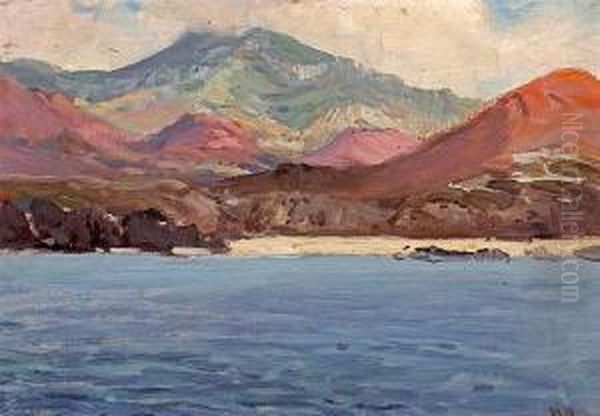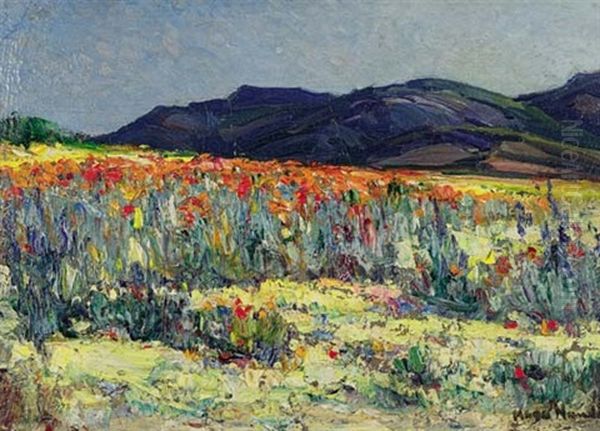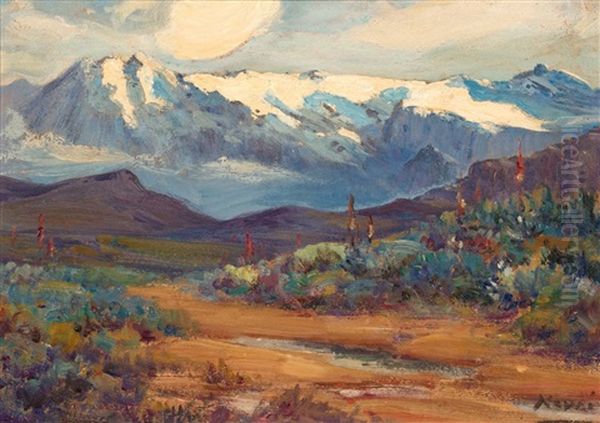Hugo Pieter Naude stands as a seminal figure in the annals of South African art history. Born in the Cape Colony during a period of burgeoning colonial identity and artistic exploration, Naude would rise to become one of the nation's first professional, academically trained painters. His life and work are a testament to a deep engagement with both European artistic traditions and the unique, vibrant landscapes of his homeland. Through his canvases, Naude not only captured the breathtaking beauty of South Africa but also helped to forge a distinctly South African artistic voice, heavily influenced by the Impressionist movement yet uniquely adapted to the southern African light and environment.
Early Life and Formative Influences
Hugo Pieter Naude, often affectionately known as Pieter, was born on July 23, 1869, in the Worcester district of the Cape Colony, on a farm named "Aan-de-Doorns." This farm belonged to his maternal family, and his second name, Pieter, was derived from his mother's maiden name. Growing up amidst the picturesque landscapes of the Western Cape, with its dramatic mountains and fertile valleys, undoubtedly sowed the early seeds of his artistic inclinations. The region's unique flora, intense light, and expansive vistas would later become central themes in his oeuvre.
His early education was local, but his artistic talent became apparent, prompting a desire for formal training that was not readily available in South Africa at the time. This ambition set him on a path that would distinguish him from many of his local contemporaries, marking him as a pioneer who sought out the best artistic education Europe had to offer. This decision was crucial, as it exposed him to the prevailing artistic currents that were then revolutionizing European art.
A European Sojourn: The Making of an Artist

Recognizing the need for advanced instruction, Naude embarked for Europe in 1889. His first significant stop was London, where he enrolled at the prestigious Slade School of Fine Art. At the Slade, he studied under the tutelage of Alphonse Legros, a French-born painter, etcher, and sculptor who had become a naturalized British citizen and was a significant figure in the British art education system. Legros, known for his traditionalist approach and emphasis on draughtsmanship, would have provided Naude with a solid grounding in academic techniques. The Slade itself was a hub of artistic innovation, and exposure to its environment would have been invaluable.
Following his time in London, Naude moved to Germany, furthering his studies at the Kunst Akademie in Munich from 1890 to 1894. Munich at this time was a major European art center, rivaling Paris in some respects, particularly in academic training and certain modernist tendencies. Here, he studied under Franz von Lenbach, a renowned portrait painter whose sitters included some of the most prominent figures of the era, such as Otto von Bismarck and Richard Wagner. Lenbach's influence might have honed Naude's skills in capturing likeness and character, though Naude would ultimately become more famous for his landscapes. He also received instruction from Adolf Hölzel, a key figure in the development of abstract art, though Hölzel's more radical ideas would likely have been in their nascent stages during Naude's time there.
Perhaps one of the most transformative experiences of his European education was his period spent in France. Around 1895, Naude traveled to Fontainebleau, near Paris, where he spent a year working alongside artists associated with the Barbizon School. This school, which included painters like Jean-Baptiste-Camille Corot, Jean-François Millet, and Théodore Rousseau, emphasized realism in landscape painting and the practice of plein air (outdoor) painting. Their dedication to capturing the direct impressions of nature, the effects of light and atmosphere, profoundly influenced Naude and steered him towards landscape painting, laying the groundwork for his later Impressionistic style.
Return to South Africa: Forging a National Style
Armed with a comprehensive European artistic education, Hugo Naude returned to South Africa in 1896. He initially settled in the Worcester district, his birthplace, and began to apply the techniques and philosophies he had absorbed abroad to the local scenery. South Africa presented a vastly different visual environment from Europe: the light was harsher and clearer, the colors more intense, and the landscapes possessed a raw, untamed quality. Naude embraced these challenges, adapting his palette and brushwork to capture the unique character of his homeland.

He became one of the first South African artists to systematically apply Impressionist principles to the local landscape. While European Impressionism, pioneered by artists like Claude Monet, Camille Pissarro, and Pierre-Auguste Renoir, focused on capturing fleeting moments and the subjective experience of light and color, Naude translated these concerns to the sun-drenched vistas of the Cape, the arid beauty of Namaqualand, and the dramatic Drakensberg mountains. His work was characterized by vibrant colors, broken brushstrokes, and a keen sensitivity to atmospheric effects.
Naude was not working in isolation. The early 20th century saw the emergence of a more professionalized art scene in South Africa. In 1902, he became a member of the South African Society of Artists (SASA), an important organization that provided a platform for local artists to exhibit their work and engage with one another. His involvement with SASA placed him at the heart of the developing South African art world, alongside other notable figures who were also striving to define a local artistic identity.
Thematic Exploration: Capturing the Soul of the Land
Hugo Naude was an inveterate traveler within Southern Africa, constantly seeking out new subjects and inspirations. His artistic journeys took him to some of the most iconic and visually stunning regions of the subcontinent. He is particularly renowned for his depictions of Namaqualand in springtime, when the arid landscape erupts into a riot of colorful wildflowers. These Namaqualand scenes are among his most celebrated works, showcasing his mastery of color and his ability to convey the ephemeral beauty of this natural phenomenon.
Beyond Namaqualand, Naude painted extensively throughout the Cape, capturing its majestic mountain ranges, verdant winelands, and rugged coastlines. He also ventured further afield, to the Transvaal (now part of Gauteng, Limpopo, Mpumalanga, and North West provinces) and to the magnificent Victoria Falls on the Zambezi River. These expeditions provided him with a diverse range of subjects, from the sun-baked plains of the interior to the misty grandeur of one of the world's largest waterfalls.
His dedication to plein air painting meant that he often worked directly from nature, setting up his easel outdoors to capture the immediate impressions of light and atmosphere. This practice lent his work a freshness and spontaneity that was characteristic of Impressionism. He was also proficient in silverpoint, an exacting drawing technique using a silver stylus on a prepared surface, which demonstrates his underlying skill in draughtsmanship inherited from his academic training.
Naude's Artistic Techniques and Style

Naude's style, while rooted in European Impressionism and the Barbizon School's naturalism, evolved into something uniquely his own, often described as South African Impressionism. He skillfully adapted the broken brushwork technique of the Impressionists to convey the shimmering quality of South African light. His palette was often bright and vibrant, reflecting the intense hues of the local flora and the clarity of the atmosphere. He was particularly adept at capturing the subtle shifts in color and tone that occurred at different times of day and under varying weather conditions.
While landscape was his primary focus, Naude also produced portraits and genre scenes. An early work, "Cape Kitchen Interior," shows the influence of 17th-century Dutch interior paintings, likely a result of his academic training in Munich. However, it is his landscapes that define his artistic legacy. Works such as "Spring in Namaqualand," "Coastal Cape Landscape," and "Brandwacht Mountains" (depicting the mountains near Worcester, often shrouded in mist after winter rains) are iconic examples of his ability to translate the South African scene into compelling artistic statements.
His approach was not merely a slavish imitation of European models. Instead, he synthesized these influences with a deep personal connection to the South African environment. He sought to capture not just the visual appearance of the landscape, but also its spirit and character. This commitment to a localized form of Impressionism helped to pave the way for subsequent generations of South African landscape painters.
A Hub for Art: Worcester and "Nodde's Artists"
Between 1903 and 1914, Hugo Naude built his own house and studio in Worcester. This home, which became known as "Nodde's Artists" or "Hugo Naude House," was more than just a residence; it evolved into an important cultural and artistic center in the town. Naude was a respected figure in the community, and his home attracted fellow artists, writers, and art enthusiasts. The house and its picturesque garden, which he also designed, often featured in his paintings and became a source of inspiration.
The establishment of his home as an artistic hub reflects Naude's commitment to fostering art in his local community. It provided a space for artistic exchange and helped to cultivate an appreciation for art beyond the major urban centers like Cape Town and Johannesburg. This aspect of his life underscores his role not just as a painter, but also as a cultural enabler. After his death, the Hugo Naude House was preserved and eventually became part of the Worcester Museum, housing a collection of his works and serving as an art center, a fitting tribute to his legacy.

During World War I, Naude also demonstrated his civic engagement by designing a rock structure for a war memorial, showcasing a practical application of his artistic skills for a community purpose. This involvement in public life, though perhaps minor in the grand scheme of his artistic output, highlights a well-rounded personality dedicated to both his art and his society.
Exhibitions and Recognition
Throughout his career, Hugo Naude's work was exhibited in South Africa and, to a lesser extent, internationally. His participation in the exhibitions of the South African Society of Artists was regular. A significant moment of recognition came in 1935 when he was awarded the Probe Prize. In the same year, his work was featured in the prestigious Empire Exhibition held in Johannesburg, a major event that showcased achievements from across the British Empire.
In 1941, the year of his passing, he received an honorary medal from the South African Royal Academy of Arts, a testament to his esteemed position in the country's art establishment. Posthumously, his work continued to be celebrated. A notable exhibition took place in Cape Town in 1941. Later, in 1948, his art was included in the Overseas Exhibition in Johannesburg, and in 1953, at the Rhodes Centenary Exhibition in Bulawayo (then Southern Rhodesia, now Zimbabwe). Major retrospective exhibitions of his work were held in 1969 at the Johannesburg Art Gallery and the South African National Gallery in Cape Town, marking the centenary of his birth and reaffirming his importance.
His paintings found their way into numerous private and public collections, including the Worcester Art Museum (housed in his former home), the Pretoria Art Museum, the Johannesburg Art Gallery, and the South African National Gallery. The continued interest in his work, evident in auction sales and scholarly attention, underscores his enduring appeal.
Contemporaries and the South African Art Milieu
Hugo Naude was a key figure in a generation of South African artists who were grappling with the task of interpreting their unique environment through the lens of evolving European artistic modes. He was a contemporary of several other important South African painters.
Jan Volschenk (1853-1936) was an older contemporary, also known for his detailed and realistic depictions of Cape landscapes, particularly the Langeberg mountains. While Volschenk's style was generally more traditional and less overtly Impressionistic than Naude's, both shared a profound love for the Cape scenery.
Pieter Willem Wenning (1873-1921), though his life was tragically short, is considered another pioneer of a more expressive, post-impressionistic style in South Africa. Wenning, influenced by the Hague School and Japanese art, often painted moody, atmospheric Cape scenes. Naude and Wenning, along with artists like Frans Oerder (1867-1944), who was Dutch-born but spent much of his career in South Africa and was known for his landscapes, portraits, and still lifes, were instrumental in moving South African art beyond purely academic or topographical representation. Oerder, like Naude, had European training and contributed significantly to the local art scene, including serving as an official war artist during the Second Boer War.
Anton van Wouw (1862-1945), primarily a sculptor, was another leading figure of this era. Though working in a different medium, van Wouw shared with Naude a commitment to representing South African subjects, famously creating iconic bronze sculptures of Boer figures and indigenous peoples.
Other notable artists active during Naude's time or slightly overlapping, who contributed to the rich tapestry of early 20th-century South African art, include Nita Spilhaus (1878-1967), known for her delicate Impressionistic landscapes and tree studies, particularly around Cape Town. Gwelo Goodman (1871-1939) was another prominent artist whose style, often bold and colourful, captured South African landscapes, including the vibrant flower fields of Namaqualand, much like Naude. Strat Caldecott (1886-1929) was an early proponent of Post-Impressionism in South Africa.
The period also saw the rise of artists who would become major figures in South African modernism, such as Maggie Laubser (1886-1973) and Irma Stern (1894-1966). While their expressive and often German Expressionist-influenced styles differed significantly from Naude's Impressionism, they shared his commitment to finding an authentic artistic language for South African subjects. The towering figure of J.H. Pierneef (1886-1957), known for his stylized and monumental depictions of the South African highveld, also emerged during this period, offering yet another distinct vision of the local landscape.
Naude's teachers in Europe, Alphonse Legros and Franz von Lenbach, were significant artists in their own right, and their instruction provided him with a strong technical foundation. The influence of the Barbizon School artists, such as Jean-Baptiste-Camille Corot and Jean-François Millet, was crucial in shaping his approach to landscape painting.
Legacy and Enduring Influence
Hugo Pieter Naude passed away on April 5, 1941, in his beloved Worcester. He left behind a rich legacy as one of South Africa's foremost landscape painters and a pioneer of Impressionism in the country. His significance lies not only in the aesthetic quality of his work but also in his role as one of the first professionally trained South African artists to dedicate his career to interpreting the local environment.
He demonstrated that European artistic movements could be meaningfully adapted to reflect the unique conditions of light, color, and form found in Southern Africa. His paintings of Namaqualand, in particular, have become iconic representations of that region's extraordinary floral displays and have contributed to a wider appreciation of South Africa's natural heritage.
Naude's influence extended to subsequent generations of artists. Piet van Heerden (1917-1991), for example, was directly inspired by Naude and continued the tradition of Cape Impressionist landscape painting. More broadly, Naude's success helped to validate landscape painting as a significant genre within South African art and encouraged other artists to explore the richness of their own surroundings.
His home in Worcester, preserved as the Hugo Naude Art Centre, continues to serve the community and stands as a monument to his life and work. His paintings remain highly sought after by collectors and are prized for their beauty, their historical significance, and their heartfelt portrayal of the South African land.
Conclusion
Hugo Pieter Naude occupies an honored place in South African art history. As a bridge between European artistic training and a burgeoning local art scene, he played a crucial role in shaping a South African visual identity. His dedication to capturing the unique light and landscapes of his homeland, through a style infused with Impressionist sensibilities, resulted in a body of work that is both historically important and aesthetically enduring. From the flower-carpeted expanses of Namaqualand to the misty mountains of the Cape, Naude’s canvases offer a vibrant and personal vision of South Africa, securing his reputation as a master of South African landscape painting and a true pioneer of his time. His life's work continues to inspire and to remind us of the profound connection between an artist and their environment.